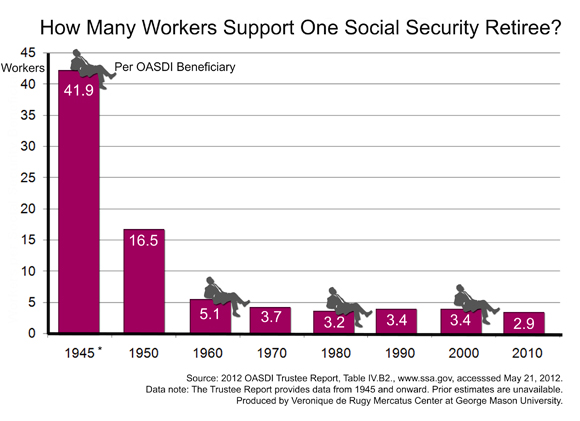- | Government Spending Government Spending
- | Data Visualizations Data Visualizations
- |
How Many Workers Support One Social Security Retiree?
With the Social Security Trust Fund exhausting faster than expected, another obstacle to the sustainability of the program is rearing its head: Social Security benefits rest on fewer and fewer taxpayers. This week's chart by Mercatus senior research fellow Veronique de Rugy uses data from the 2012 Social Security Trustees Report to show the number of workers that need to contribute to the system to ensure the benefits for one retiree.
With the Social Security Trust Fund exhausting faster than expected, another obstacle to the sustainability of the program is rearing its head: Social Security benefits rest on fewer and fewer taxpayers. This week's chart by Mercatus senior research fellow Veronique de Rugy uses data from the 2012 Social Security Trustees Report to show the number of workers that need to contribute to the system to ensure the benefits for one retiree.
Most of the major shifts in worker-to-beneficiary ratios before the 1960s are attributable to the dynamics of the program's maturity. In the early stages of the program, many paid in and few received benefits, and the revenue collected greatly exceeded the benefits being paid out. What appeared to be the program's advantage, however, turned out to be misleading. Between 1945 and 1965, the decline in worker-to-beneficiary ratios went from 41 to 4 workers per beneficiary.
The Social Security program matured in the 1960s, when Americans were consistently having fewer children, living longer, and earning wages at a slower rate than the rate of growth in the number of retirees. As these trends have continued, today there are just 2.9 workers per retiree—and this amount is expected to drop to two workers per retiree by 2030.
The program was stable when there were more than 3 workers per beneficiary. However, future projections indicate that the ratio will continue to fall from two workers to one, at which point the program in its current structure becomes financially unsustainable.
*Note on the data: At the inception of Social Security in 1935, there were few beneficiaries and a lot of workers. (See the number of beneficiaries per 100 covered workers inTable IV.B2 of the Trustees Report). As the post-WWII baby boomers were born, the worker-to-beneficiary ratio increased. As birth rates decline and the baby boomers retire, the worker-to-beneficiary ratio is on the decline. The increased longevity of Americans only further compounds the problem.


